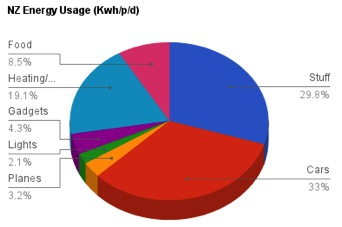Welcome to the sixteenth and final post in the Sustainable Energy without the Hot Air – A New Zealand Perspective series.
To recap, we started with a bit of energy accounting and worked out that Kiwi’s use around 88 kWh/d/p (methodology for what the kWh/d/p means is here), and that of this, about 33kWh/d/p came from sustainable sources or we couldn’t substitute. As a result, we’ve been looking for how to shift the remaining 55kWh/d/p of our current energy use to renewable energy sources. We approached this in two ways:
How much could we increase our energy generation capacity in renewable sources?
Here, we looked at hydro power, geothermal and wind (and a summary on the big three), solar, biofuels, marine and waste energy and did some basic calculations on the overall potential of these sources. Then:
How much could we achieve a BIG reduction in our personal and national energy consumption, and where those savings would come from.
We went through the areas of energy use for Kiwis, including road, air transport, home energy use and general consumption before doing some calculations on the overall reductions we think we could make.
What might it cost to achieve an all-renewable energy economy?
Today, we’re looking at how this might translate into action at a national level. This post contains both some costing, and suggestions for action that might effectively be channeled into effective change.
Continue reading “Grand final: Sustainable Energy NZ #16 – counting up the dollars and sense”

 Last week business lobby group
Last week business lobby group  Welcome to the fiftheenth post in the Sustainable Energy without the Hot Air – A New Zealand Perspective series. After our previous posts on
Welcome to the fiftheenth post in the Sustainable Energy without the Hot Air – A New Zealand Perspective series. After our previous posts on 
 Welcome to the fourteenth post in the Sustainable Energy without the Hot Air – A New Zealand Perspective series. After our previous posts on
Welcome to the fourteenth post in the Sustainable Energy without the Hot Air – A New Zealand Perspective series. After our previous posts on  Welcome to the thirteenth post in the Sustainable Energy without the Hot Air – A New Zealand Perspective series. After our previous posts on
Welcome to the thirteenth post in the Sustainable Energy without the Hot Air – A New Zealand Perspective series. After our previous posts on
You must be logged in to post a comment.